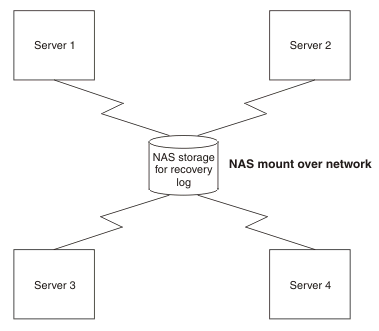Deployment considerations for transactional high availability
Before you use the high availability (HA) function, consider deployment issues such as your file system type, or where you plan to store the transaction recovery logs. In particular, your file system type can have important consequences for your recovery configuration.
Common configuration
Transaction peer recovery requires a common configuration of the resource providers between the participating server members to perform peer recovery between servers. Therefore, peer recovery processing can only take place between members of the same server cluster. Although a cluster can contain servers that are at different versions of WebSphere Application Server, peer recovery can only be performed between servers in the cluster that are at V6 or later.
Physical storage
For appservers to perform transaction peer recovery for each other, they must be able to access the transaction recovery logs of all the other members in the cluster. Ensure that the log files are stored on a medium that is accessible by all members of the cluster, and that each cluster member has a unique log file location on this medium. This medium, and access to it, for example through a local area network (LAN), must support the file-based force operation that is used by the recovery log service to force data to disk. After the force operation is complete, information must be persistently stored on physical disk media.
For example, you can use IBM Network attached storage (NAS) (http://www.ibm.com/servers/storage/nas/index.html) mounted on each node, and shared SCSI drives, but not simple network share. All nodes must have read and write access to the recovery logs. Figure 1. Recovery logs on NAS storage are available to all servers

In addition, configure the mechanism by which the remote log files are accessed, to exploit any fault tolerance in the underlying file system. For example, by using the Network File System (NFS) and hard mounting the remote directory containing the log files using the -o hard option of the NFS mount command, the NFS client will retry a failed operation until the NFS server becomes available again.
Two types of potential server failure exist: software failure and hardware failure. Software failures generally do not affect other appservers directly. Even servers on the same physical hardware can perform peer recovery processing. If a hardware failure occurs, all the servers that are deployed on the failed hardware become unavailable. Servers on other hardware are required to handle peer recovery processing. Any HA configuration requires that servers are deployed across multiple and discrete hardware systems.
File system
The file system type is an important deployment consideration as it is the main factor in deciding whether to use automated or manual peer recovery. For more information, see How to choose between automated and manual transaction peer recovery.
Sub-topics
How to choose between automated and manual transaction peer recovery
Related concepts
Transactional high availability
Related tasks
Configure transaction properties for peer recovery